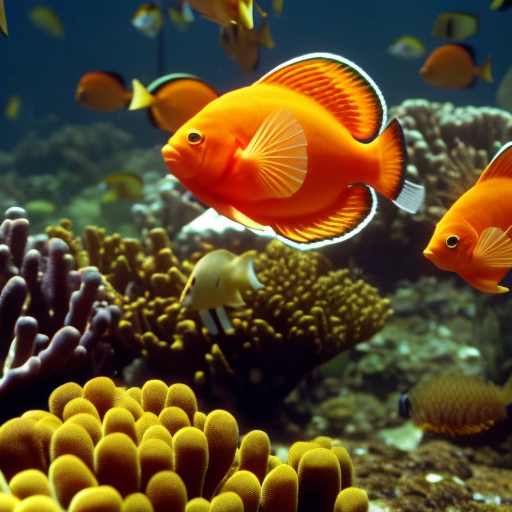
U.S. Rep. Ed Case Introduces Legislation to Restrict Imports of Protected Ornamental Reef Fish and Coral
U.S. Representative Ed Case, a Hawaii Democrat, has proposed a new legislation called the Saving Natural Ecosystems and Marine Organisms Act. The bill aims to limit the international imports of protected ornamental reef fish and coral that are collected through destructive practices. On November 17, Case introduced the legislation to the House, and it has been referred to the House committees on Natural Resources, Ways and Means, and Foreign Affairs.
High Demand for Ornamental Reef Fish and Coral Threatens Coral Reefs
Case highlighted that the United States is the largest importer of ornamental reef fish, which are fish kept in aquariums or for aesthetic purposes. The high demand for these fish and coral leads to destructive collection practices that harm the health of coral reefs. In his statement to the House, Case emphasized the importance of oceans to life on our planet and the billions of people who rely on its resources. While sustainable collection practices exist, the demand often exceeds sustainable levels, resulting in unsustainable and destructive practices.
Addressing Destructive Practices in Countries with Weak Regulations
Case pointed out that much of the collection of ornamental reef fish and coral occurs in countries with inadequate regulations against destructive practices. He acknowledged that the United States has a responsibility for creating the demand that drives these practices and has an opportunity to redirect that demand towards sustainable collection practices.
Petition for Rule-Making on Prohibition of Fishing for Commercial Aquarium Purposes
Prior to the introduction of the Saving Natural Ecosystems and Marine Organisms Act, various organizations submitted a petition for rule-making on the prohibition of fishing for commercial aquarium purposes. The petition raised concerns about climate change, cultural values, and the need for community input in the decision-making process.
Department of Land and Natural Resources’ Response
In response to the petition, the Department of Land and Natural Resources’ Division of Aquatic Resources (DAR) recommended that the Land Board reject the initial petition. DAR cited an existing process in place where they evaluate aquarium fishing permits. The Land Board did not issue a total ban on fishing for commercial aquarium purposes, but instead instructed DAR to consider the petitioner’s request and proceed with rule-making in accordance with statutory provisions.
Status of the Saving Natural Ecosystems and Marine Organisms Act
Case’s Saving Natural Ecosystems and Marine Organisms Act is still under consideration in the House. The schedule for committee hearings on the bill has not yet been determined.
SDGs, Targets, and Indicators in the Article
1. Which SDGs are addressed or connected to the issues highlighted in the article?
- SDG 14: Life Below Water – This goal focuses on the conservation and sustainable use of the oceans, seas, and marine resources.
- SDG 15: Life on Land – This goal aims to protect, restore, and promote sustainable use of terrestrial ecosystems, sustainably manage forests, combat desertification, and halt biodiversity loss.
2. What specific targets under those SDGs can be identified based on the article’s content?
- SDG 14.2: By 2020, sustainably manage and protect marine and coastal ecosystems to avoid significant adverse impacts, including by strengthening their resilience and taking action for their restoration, to achieve healthy and productive oceans.
- SDG 15.5: Take urgent and significant action to reduce the degradation of natural habitats, halt the loss of biodiversity, and protect and prevent the extinction of threatened species.
3. Are there any indicators mentioned or implied in the article that can be used to measure progress towards the identified targets?
The article does not explicitly mention any indicators. However, indicators that could be relevant to measure progress towards the identified targets may include:
- Extent of protected marine and coastal areas
- Number of destructive collection practices reduced
- Population trends of ornamental reef fish and coral species
- Regulation strength in countries with high collection rates
Table: SDGs, Targets, and Indicators
| SDGs | Targets | Indicators |
|---|---|---|
| SDG 14: Life Below Water | Sustainably manage and protect marine and coastal ecosystems | Extent of protected marine and coastal areas |
| SDG 15: Life on Land | Reduce the degradation of natural habitats and protect threatened species | Number of destructive collection practices reduced Population trends of ornamental reef fish and coral species Regulation strength in countries with high collection rates |
Behold! This splendid article springs forth from the wellspring of knowledge, shaped by a wondrous proprietary AI technology that delved into a vast ocean of data, illuminating the path towards the Sustainable Development Goals. Remember that all rights are reserved by SDG Investors LLC, empowering us to champion progress together.
Source: hawaiitribune-herald.com

Join us, as fellow seekers of change, on a transformative journey at https://sdgtalks.ai/welcome, where you can become a member and actively contribute to shaping a brighter future.






